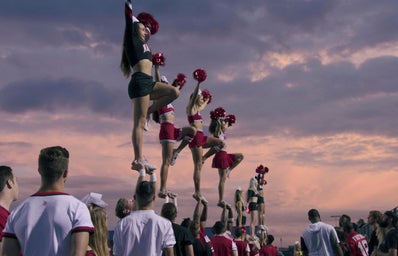The hit Netflix docuseries Cheer first came out when I was a freshman in college. At the time, I was desperately missing the camaraderie and athleticism of my high school cheerleading squad. I started cheering when I was 16, as I had grown tired of competitive dance and wanted to join a sport that was more team-oriented, but that also included elements of choreography and performance. Cheerleading was just that.
The three years I spent on the cheer team were some of the best years of my life, giving me several of my closest friends and dearest memories, as well as keeping me fit and competitive. Cheer became so important to me that I even ended up becoming the captain of my team when I was a senior, an experience that I absolutely adored and that taught me so much.
The sun setting while my teammates and I sang in the car on the way to practice, the ache in my bones from practicing a stunt over and over until it was perfect, thick hairspray, lost hair bows, holding hands and chanting before we performed, adrenaline pumping, burning muscles, cheering through blazing heat and bitter cold, screams for victory and girls flipping in the air, and bright, glowing smiles fixed on our faces— these are the things I love about cheer.
I miss it so, so much sometimes.
So the delight that my former teammates and I felt when Cheer came out on Netflix was palpable. Finally, we could watch our sport represented on the silver screen and have people recognize the grit, tears, and incredible strength that goes into competitive cheerleading.
That being said, I remember also being nervous in the days following the initial release of Cheer. What if it was a bust? What if no one watched, or it just showed tacky girls with high ponytails catfighting? What if it focused only on sideline cheer and glittery uniforms, denying cheerleaders the chance to prove their talent and hard work?
Of course, now we know my fears were unfounded. There has been controversy and drama surrounding the show, yes, but overall it was an absolutely smashing success.
The coach, Monica Aldama, and several of the cheerleaders highlighted on the show now enjoy borderline celebrity status and have become absolute icons in the cheerleading world, even more so than before. They have been on some of the largest talk-shows in the United States, have gone to A-list events, and now boast millions of social media followers. Season 2 of Cheer just came out this past January, and more seasons are quite likely to be made. The show made a mark—a powerful, lasting, and somewhat surprising mark.
I say the show’s success is somewhat surprising because it is a show that highlights almost exclusively women, girls, and gay men while unapologetically staying true to the heart of cheerleading without trying to masculinize it or make it more stereotypically “athletic.”
Cheer demands that the audience accept co-ed cheerleading as it is: populated almost exclusively by tiny, fierce girls and strong, flamboyant men, and still deeply athletic. Young girls with long hair and lash extensions, young men who wear sports bras and love to twerk––these people have as much strength, skill, and power as any football or basketball team.
There is no Superbowl for women. The American women’s soccer team gets paid criminally less than the men’s team, despite being far more successful. Women’s collegiate basketball teams were just granted permission to use “March Madness” labeling in September 2021. All of this (and more) illustrates the clear disparity between how women and men are treated and valued in sports, and everyone knows it.
But women and girls do care about sports. We do want to cheer for our favorite teams, to experience the thrill of winning, to feel that satisfying burn and ache from pushing our bodies to their limits. But for so long, women’s sports have been essentially bottom-tier, always viewed as inferior to those of men, barely on TV and almost never on primetime.
Cheer subverted that trope, creating a show that highlights women doing things that most men can simply not do, like flipping themselves three or four times in the air and balancing their entire body on a man’s palm. Cheer did not shy away from its female audience, instead showcasing music geared towards women, uniforms geared towards women, as well as accessories, jokes and dramatic scenes geared towards women.
The creative choices and the cast of the show were not meant to pull in or prioritize the stereotypical sports audience, but to entertain and awe the straight girls and gay boys who predominantly idolize cheerleading. By staying true to that base, it became a smash-hit, because as aforementioned, women and gay men are just as competitive, passionate, and strong as straight men—if not more so.
Cheer was exactly the show that I so wanted it to be, a show that brought back all of the beautiful memories of unapologetically female friendship, complete trust and respect between female flyers and male bases, and the deep-seated desire to prove to all of the boys on the football and wrestling teams that we could do things that they couldn’t dream of––that we were athletes just as much as they were.
Cheer highlighted how you can be a girl who loves bubble baths and sparkles and also have blisters from years of brutal competitions, that you can be a boy who loves to sashay and wear wigs while also being able to catch and throw hundreds of pounds above your head like a doll.
Cheer is a show that gave voice and agency to the most relegated, ignored athletes in the country, which in turn gave voice and agency to the girls and boys who give their all to cheerleading while knowing that their awe-inspiring talent will be constantly overlooked by society and media. By refusing to sacrifice the heart and soul of cheerleading and still highlighting the harsh, unforgiving physical nature of the sport,
Cheer changed the game for good in terms of female-centric sports and representation—and was also just incredibly fun to watch.
Want to keep up with HCBU? Make sure to like us on Facebook, follow us on Instagram, check out our Pinterest board, and read our latest Tweets!


